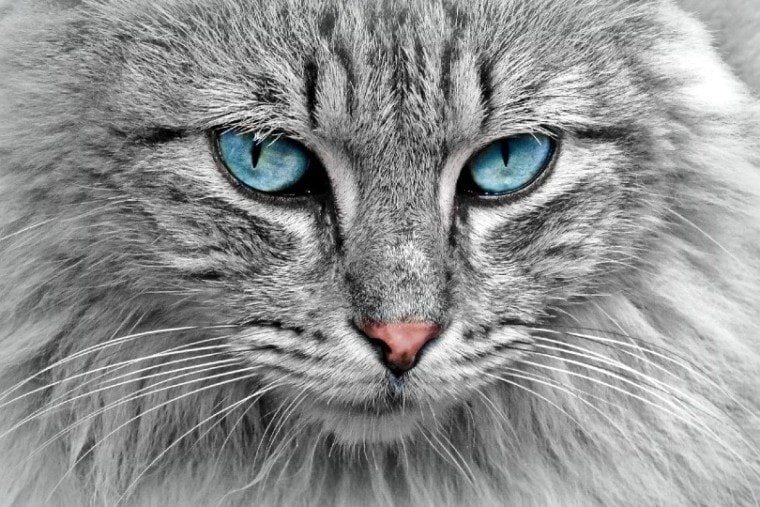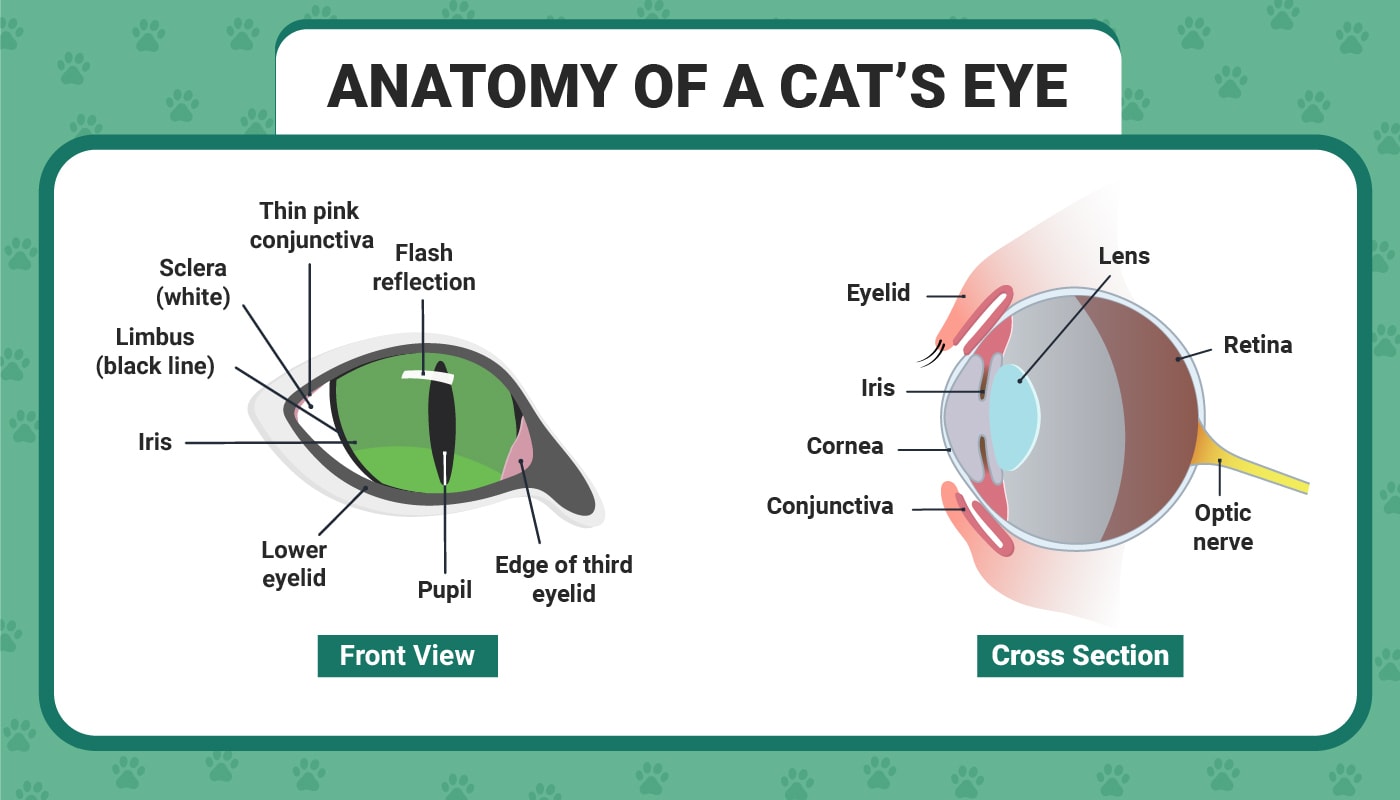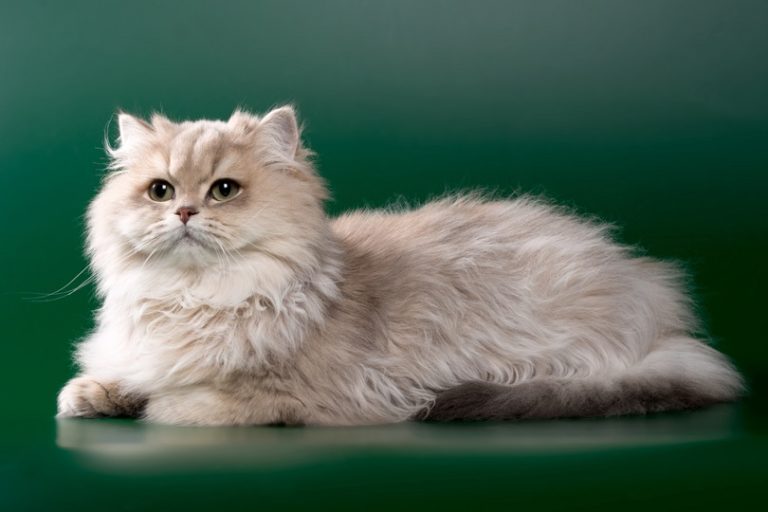
Cats can’t see the same range of colors as humans, but they don’t see the world in complete grayscale, as some believe. Exactly which colors cats can see is a hotly debated topic in science. Some believe that cats can only see blue and gray. At the same time, others argue that cats should be able to see yellows as well. Here’s what science knows so far!
Color Vision: How Does It Work?
Our eyes perceive color through a series of nerves in the eye. There are two kinds of nerves in the retina, rods, and cones. The cones are what allow us to differentiate colors. Like humans, cats have cones that will identify red, blue, and green shades.
However, the human eye has about ten times the color cones that a cat’s eye has. So, humans see a more significant variation of color than felines. While we can perceive the same types of colors, we have a greater color resolution. So, where a human could differentiate between reds and pinks, a cat may see them as the same color.

What Colors Can Cats See?
The colors cats can see most accurately are blues and violets. While they have cones to see red and green, fewer of those cones and cats don’t see the colors as vividly. They’ll have trouble differentiating between the colors that they have fewer cones for.
There’s debate in the science community about whether cats can see yellows. While dogs have specific cones dedicated to seeing yellow, cats have cones for red, green, and blue, like humans. Humans can see yellows, so logically we could only assume that cats can see yellows.
However, since dogs have cones specifically designed for yellow and cats have neither cones for yellow nor as many cones as humans, it’s unclear whether or not they can perceive yellows. We can’t just ask them, so we must rely on other methods of observation.
Does This Mean Cats Have Poor Vision Compared to Humans?
No, not at all! Cats did not become one of nature’s greatest hunters because of their poor vision and even some of nature’s other greatest hunters have genuinely poor vision. Cats compensate for these differences in their sight with other senses and even other differences in their vision.
Several other differences between human and cat senses allow cats to compensate for their diluted color vision.
For starters, cats have vastly more rods in their eyes than humans do. They have a tapetum lucidum to help them see in the dark. They have a greater field of view than humans. These are without even delving into their other senses.

The 4 Differences Between Cats & Human Eyes
1. Rods vs. Cones
Cones are used for day vision and color differentiation. On the other hand, rods are used to detect light in low-light scenarios. Cats have six to eight times more rod cells than humans do. So, they can see in the dark six to eight times better than humans.
Having more rods means that the cat’s eyes are more sensitive to light in general. This is great at night but can be harsh during the day when the light is bright. Cats are nocturnal by nature, so it makes sense that their eyes are adapted for nighttime use.
- Related Read: 10 Cat Breeds with Blue Eyes (with Pictures)
2. Elliptical Pupils
Cats also have elliptical pupils while humans have round ones. Elliptical pupils take in more light because they dilate. This allows more light to reach the retina even before we account for the number of rod cells present to capture it.
Elliptical pupils constrict much faster than round pupils and can dilate much further. While a cat’s eyeballs aren’t that much smaller than a human’s, their pupils are three times bigger. So, your cat can take advantage of the tiniest amount of light in the dark.
Not all cats have elliptical pupils. Big cats such as lions and tigers have round pupils like humans. Pupil shape and size vary from animal to animal and adapt to their natural habitat and position in the food chain.
Herbivorous prey animals tend to have horizontal pupils, while predators that hunt during the night or day and night tend to have vertical pupils. Predators who usually hunt during the day tend to have round pupils.

3. The Tapetum Lucidum
The phrase “tapetum lucidum” means “bright tapestry” in Latin. It’s a reflective layer inside the eye that acts as a retroreflector for light entering the eye. Retroreflectors reflect light back to the light source with the goal of the light following the same path that it followed.
By reflecting light back through the retina, each light particle that enters the cat’s eye can light their vision twice. To understand the exact workings of the tapetum lucidum, we have first to know how brains perceive images.
Light first enters the eye through the cornea, which bends the light to help the eye focus. Some of the light enters the pupil and goes to the back of the eye where the retina is. The retina takes the light particles that enter it and transforms the light into electric signals that the brain can use to form a picture.
The tapetum lucidum must function as a retroreflector, not just a mirror. A regular mirror doesn’t control where the light it reflects goes. This can result in what’s called the scattering of light. If the tapetum lucidum scattered the light reflected, the cat’s vision would be distorted because the retina would send a different image to the brain.
Since the tapetum lucidum reflects the light on the same path that it hit the tapetum lucidum with, it hits the retina in the same place that it did on the way in, and the light doesn’t muddle the brain’s ability to perceive the image.
Cats are not the only animals with a tapetum lucidum. Dogs, birds, and many other nocturnal creatures also have a tapetum lucidum.
- You might also be interested in: How Old Are Kittens When They Open Their Eyes?
4. Eye Position
Cat’s eyes are positioned slightly to the side of their heads. Their field of view is about ten degrees wider on either side, which doesn’t sound like much, but a ten-degree angle is quite significant.
This more expansive field of view allows the cat to keep tabs on things in its peripheral vision while hunting.
- Related Read: Do Cats’ Eyes Change Color?
Final Thoughts
While the cat’s color vision may be a hotly debated topic, we understand more and more about how their vision works every day. From the cones present in their eyes to the tapetum lucidum, cats have evolved to suit their needs as nocturnal predators. Even if they can’t see the same range of color that we do, their other adaptations to their vision and senses keep them at the top of the food chain!
See also:
- Can Cats Catch Colds? Symptoms, Causes, and Care
- Can Cats Eat Bean Sprouts? Are They Healthy for Them?
- Can I Clone My Cat? Feasibility and Ethical Considerations
Featured Image Credit: cocoparisienne, Pixabay






